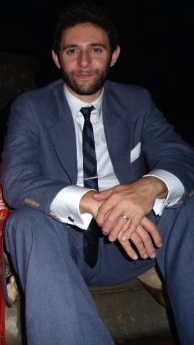

Adam Levine, Visiting Assistant Professor in Film and Media Studies, received a B.A. from the University of East Anglia and an M.F.A. from the California Institute of the Arts. His film and video work has screened at festivals and galleries including the Vienna International Film Festival, Festival des Cinémas Différents et Expérimentaux de Paris, TIE: The International Experimental Cinema Exposition, Artists’ Television Access and REDCAT.
Q: What sparked your interest in Film and Media Studies?
A: I grew up as a VHS kid. In my early teens, my mom would take me to a video store. I consumed movies on a weekly basis. So I had this whole video store education. At university. I took a lot of theory classes — in global cinema, Asian cinema, French film from surrealism to the new age ... And then I took one film class in undergrad where I made surreal films with my friends. And after college, I bought my own video camera.
Q: What types of films have you created?
A: I make mostly short films. My shortest film is two minutes. It was an experimental film that I shot in Thailand. I wanted to make a haiku. A film haiku. Very compressed. So I was carrying these [60 mm] films around Thailand, and each of these is 2 ½ minutes. So, I just had a backpack with a camera in it, and as many of these as I could fit.
I’ve also made essay films, where you have an idea that’s you’re exploring. I’ve used voice-overs over to explain an idea. And then used images to illustrate that.
Q: How do you shoot films?
A: I mostly shoot on my own. I kind of like the challenge of doing everything yourself. I go out and gather footage — almost kind of like a street photographer. Like Brassai, who would take candid photography in the streets of France. Wherever he would go, whatever he was doing in life, he would just carry a camera around with him — so he would just capture real life as he was walking around. He was hoping for a chance image he would see that he could then capture. So I kind of think about that in the way that I make films — I try to use small cameras and carry them around with me. Because that’s the only way you can get things you would never be able to plan for ... I’m always making things. And it’s very hands-on.
Q: Do you gravitate towards certain themes in your films?
A: Until now, I’ve always lived in big cities. And so I was always interested in how to look on the urban environment through film. And what effect the urban environment is having on us as individuals. And how a filmmaker can show the urban environment through a different lens.
Another theme is portrait films. I’m teaching a class now called “The Film Portrait”. And that’s where you find a really interesting person, and you work with them to show their personality through the film. It’s a little bit like a documentary, but it doesn’t have to be totally truthful. You can tell them what to do —you can collaborate with them. So I’ve made a lot of film portraits of people who have unusual practices. For example, I made a film about a blacksmith — which seems a bit out of place in 2014. Why would someone do that now? And what does that person’s life look like? Are they building an imaginary [old-fashioned] life around what they do?
Q: What are you working on currently?
A: I’ve been making a film in Los Angeles with a friend of mine. It’s going to be a feature length film about the oldest freeway in Los Angeles. It’s kind of what we call a city portrait. We’re following the freeway to look at the city — to see how the city functions. We show the different communities of Los Angeles, and we get aspects of the infrastructure ... We have cameras and we shoot still frames, but we shoot bursts of them all at once. It’s of reality but it’s very visually different.
I’m also working on some footage that I’ve shot out in New England. Wherever I am, I always like to have a film I’ve made — to reflect the place I’ve lived. So I need my New England film. I live up in Greenfield. And there’s an abandoned water pumping station up there. It’s kind of like a swimming hole with a covered bridge over it. And so I keep returning to it, and filming it, and capturing the sound of the water.
Q: What are your influences?
A: Definitely surrealism, and dare I say it, certain aspects of French theory. Although I’ve never studied it in a serious academic sense … rather as a dilettante. Honestly, visual art that isn’t film is very influential to me. I look at sculptures, painting, and photography and concept art. And writing — fiction and creative nonfiction.
Q: That’s interesting. You like to bring different fields into film.
A: Well, things that I like from those fields. I have a class, called “The Essay Film”, and the question we ask in that class is “Can we write with a camera the same way we can write with a pen? Can we get ideas out through a camera the same way?” I think we need to think more about what aspects of the moving image we are not using. I’m not anti-Hollywood. I love the narrative Hollywood film, but I’m trying to explore the rest of spectrum of the moving image and what we can do with it.